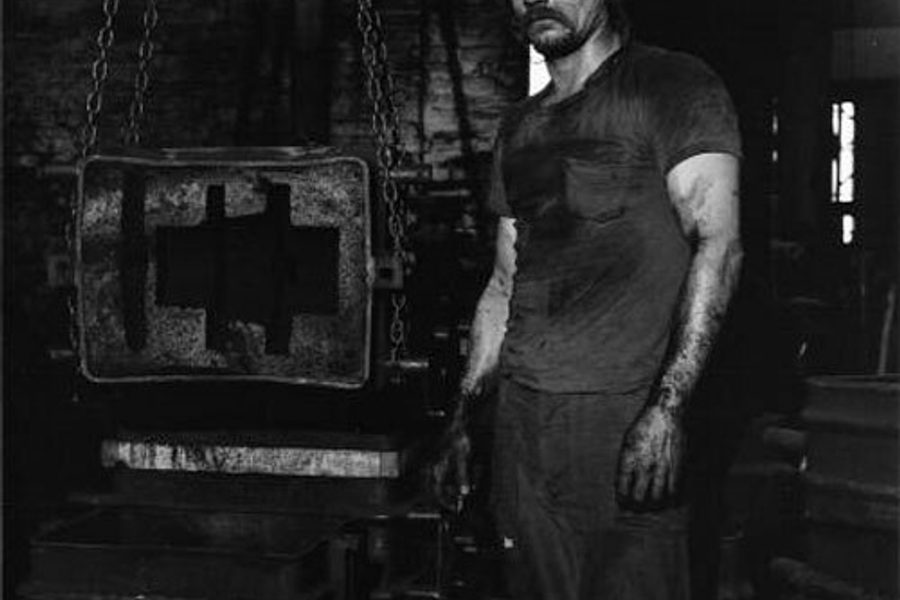
Milton Rogovin, dubbed “Buffalo’s Top Red” in the McCarthy era and a renowned chronicler of the working class, died in January at age 101.
The closing of an exhibit of Rogovin’s photographs and words at Roosevelt University’s Gage Gallery in Chicago on June 30 seems a good excuse to contemplate his timeless work – images of Appalachian miners and their families, steel workers, factory workers and residents of hard-scrabble, demographically shifting urban neighborhoods—themes he explored in decades past producing images that seem perhaps even more relevant and evocative today.
Rogovin was not like some famous photographers and writers from middle-class or privileged backgrounds who made names covering the working class. Rogovin grew up in a poor working-class Jewish family in New York, was driven to understand the economy that made it so difficult for hard-working people like his parents to survive and dedicated to fighting for social justice.
Rogovin was first an optometrist by training, and a member of the Optical Union Local 1951 until he lost his job because he joined a picket line. He was also a member of the Popular Front group of artists, writers and photographs in the 1930s using their talents to oppose fascism and oppression globally and at home.
Rogovin’s series “Working People, 1976-1987,” partially on exhibit at Roosevelt, features diptych portraits of people at work in factories, steel mills and mines; and also at home. The contrast is thought-provoking and somewhat disconcerting. The subjects aren’t immediately recognizable as the same person in the two different settings. Dressed in heavy gear, filthy and with sober expressions at work; scrubbed, dressed up and often smiling at home. In the home portraits the people are surrounded by family; at work they are pictured alone.
My first impression was to be reminded that there is a home life, a family, a vibrant and unique personal world for every person who at work might appear faceless, invisible, a cog in a machine. But on closer examination some of the portraits appeared to show people more proud, beautiful and alive in their workplace than at home; or at least expressing their personality in a different way.
A woman who worked in a ceramics factory stood at work with a jaunty posture, her face glowing with sweat and her eyes looking intensely at the camera. Surrounded by her mostly male family members at home, she looked meek and withdrawn.
A current of feminism runs through many of Rogovin’s photos of women in highly physical jobs – like Doris McKinney, a Republic Steel worker pictured in a heavy “burning suit,” goggles and helmet sitting high on her head. McKinney reflected that her friends saw the photo and said “I look like I’m from outer space.”
“The reason the hat is sitting so high,” she added (in text accompanying the photo), was “because I had my hair rolled up — you know when you get off from work you always still try to be a lady.”
And then there’s a coal miner who is pictured with face blackened and sleeves rolled up in the mine, a stark contrast to her portrait at home with a blonde bouffant, made-up eyes and cradling a poodle. In a video accompanying the photos at Roosevelt, Rogovin recited this woman’s words: “My daddy was a miner and my grandpas too. And I a single parent. What choice was there for me? To be a waitress?…with all the aches and pains I stand with my daddy and my grandpas too. To be a miner is my choice.”
He also recites his thoughts on a famous photo of foundry worker Joe Kemp, pictured shirtless with his chest glistening and direct gaze: “Joe, you were the one who cleared the channels so rivers of gold could flow…Joe, you were the one who breathed the poisonous fumes that rose from the river of gold…”
Kari Lydersen is a Chicago-based journalist, author and assistant professor at Northwestern University, where she leads the investigative specialization at the Medill School of Journalism, Media, Integrated Marketing Communications. Her books include Mayor 1%: Rahm Emanuel and the Rise of Chicago’s 99%.








